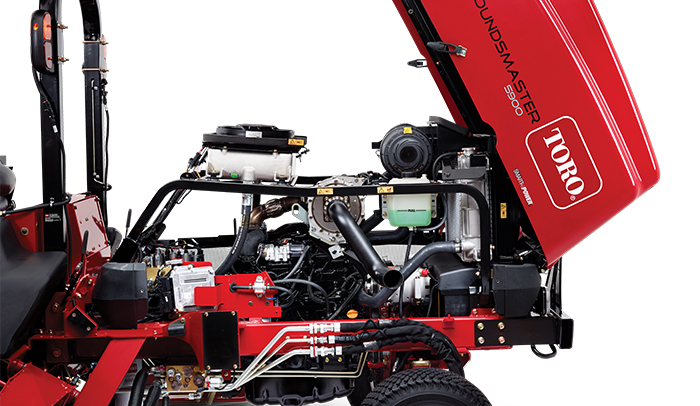Today’s Tier 4/Stage V high-pressure common-rail (HPCR) fuel systems are designed with very high tolerance/high-precision components to develop very high fuel pressure, maximizing power output while minimizing exhaust gas and particulate emissions. Because of that precision, HPCR fuel systems require a more stringent set of best practices than that of the predecessor, mechanical diesel injection systems. Before we take a look at those best practices, let’s put the difference in an extreme but relative perspective.
The mechanical diesel injection systems of the recent past could be compared to the disposal found in your kitchen sink — not so much in functional design, but more around their tolerance to variables such as fuel, fuel alternatives, and quality, as well as some contamination. Over time, once they were in need of repair, the cost was relatively reasonable.
Today’s diesel HPCR systems are more like a Swiss watch. They’re highly refined, proper maintenance is critical, and if they’re neglected, internal degradation is more rapid and can be quite expensive to replace. Not only are the components not serviceable, but a pump failure can disperse debris throughout the entire fuel system, requiring replacement.

In most cases, when fuel and/or debris contamination occurs, it tends to be less cost prohibitive to replace the entire engine assembly where the majority of these components are located than it would be to replace the components individually. In all instances of fuel system contamination or contamination with the resulting debris, repairs must include the fuel tank and line flushing and/or replacement, along with new separator/filtration parts.
The bottom line is that HPCR fuel system performance depends on the right fuel and maintenance practices. To avoid costly replacements and keep your system performing as expected, here are five fuel-related best practices to follow:
1. Use clean, ultra-low-sulfur diesel fuel.
The sulfur content of the fuel must be less than 15 ppm. If you’re using a biodiesel blended fuel, the petroleum diesel portion must be ultra-low-sulfur as well. Diesel fuel with higher rates of sulfur will degrade the diesel oxidation catalyst (DOC) and shorten the service life of engine components.
2. Purchase fuel in quantities that can be used within 180 days.
Fuel must be used within 180 days to ensure fuel freshness, whether it’s in a machine’s fuel tank or in holding/storage tanks on site. Don’t overlook secondary fuel storage/delivery systems such as those found in truck beds or fuel “jerry cans.” In addition, regular inspection, maintenance, tank cleaning and water separation/filtration should be established and performed, either by your team or the fuel delivery provider/distributor.
3. Perform regular machine fuel tank maintenance.
Drain and clean the fuel tank after every 1,000 hours of operation and before putting the machine in seasonal storage. If the machine will be in storage for more than 180 days, replace or polish existing fuel to remove contaminants.
4. Maintain the water separator, filtration, and fuel lines.
The machine water separator manages particulates down to 10 microns and “separates” water from the fuel. The diesel fuel filter aids in removing any additional, smaller particulates down to 5 microns.
- Drain water from the water separator daily or before each use.
- Replace the water separator filter canister and the engine fuel filter every 400 hours.
- Inspect fuel lines for deterioration, leaks, damage or loose connections every 400 hours.
5. Prime the fuel system. This is EXTREMELY IMPORTANT!
The fuel system should be primed after any fuel system maintenance or servicing that opens the fuel system as a whole. This is especially important when opening the low-pressure fuel delivery from the fuel tank to the supply pump, which introduces air into the system. Fuel system priming must follow to prime the supply pump with fuel, purging the air from the system to avoid supply pump fuel starvation/cavitation.
The fuel system needs to be primed:
- Before starting the engine for the first time.
- After running out of fuel and fuel has been added to the fuel tank.
- After fuel system maintenance, such as changing the fuel filter/water separator or replacing a fuel system component.
To prime the fuel system, turn the key to the ON position for 10 to 15 seconds. This will allow the electric fuel pump to prime the fuel system. Repeat this process 3 to 4 times.
Never open the fuel system in an effort to purge air. This is especially important for high-pressure hardlines on a running or recently shut down the engine. Pressure in these lines is extremely high and could result in severe injuries and even death.
Always reference machine operators, service, and engine manuals. Here are some additional warnings to keep in mind:
- Don’t run the machine with extremely low fuel levels or allow the machine to run out of fuel, stalling the engine.
- When you add fuel to the machine, fuel system priming must follow.
- Never use the starter motor on the engine to crank the engine to prime the fuel pump. This may cause the starter motor to overheat and damage the coils, pinion, and/or ring gear.
- If air is mixed in the fuel (for example, due to failure to prime, low-fuel starvation, air ingestion from loose or compromised low-pressure delivery hoses, etc.), the supply pump and injectors may seize up, and premature wear to supply pump components is highly likely.
A note about diesel particulate filter (DPF) regeneration.
Beyond the fuel-related best practices listed above, regeneration is a normal and necessary process that removes particulate matter (soot) from diesel engine exhaust. Your machine performs a variety of regeneration methods, some of which are automatic and some of which require an operator or technician to complete. For a summary of these methods, see this article.
If you have questions about these practices, contact your local Toro distributor or visit the Tier 4 page on our website for more information.





